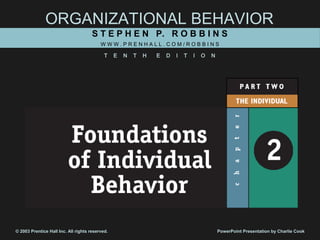More Related Content
Similar to Foundatoins of Individual Behavior
Similar to Foundatoins of Individual Behavior (20)
Foundatoins of Individual Behavior
- 1. ORGANIZATIONAL BEHAVIOR
S T E P H E N P. R O B B I N S
WWW.PRENHALL.COM/ROBBINS
T E N T H E D I T I O N
© 2003 Prentice Hall Inc. All rights reserved. PowerPoint Presentation by Charlie Cook
- 2. O B J E C T I V E S
AFTER STUDYING THIS CHAPTER,
YOU SHOULD BE ABLE TO:
1. Define the key biographical characteristics.
2. Identify two types of ability.
3. Shape the behavior of others.
L E A R N I N G
4. Distinguish between the four schedules of
reinforcement.
5. Clarify the role of punishment in learning.
6. Practice self-management
7. Exhibit effective discipline skills.
© 2003 Prentice Hall Inc.
All rights reserved. 2–2
- 5. Dimensions of
Dimensions of
Intellectual Ability
Intellectual Ability
••Number aptitude
Number aptitude
••Verbal comprehension
Verbal comprehension
••Perceptual speed
Perceptual speed
••Inductive reasoning
Inductive reasoning
••Deductive reasoning
Deductive reasoning
••Spatial visualization
Spatial visualization
••Memory
Memory
© 2003 Prentice Hall Inc. EXHIBIT 2-1
All rights reserved. 2–5
- 7. Nine Physical Abilities
Nine Physical Abilities
Strength Factors
Strength Factors
• •Dynamic strength
Dynamic strength
• •Trunk strength
Trunk strength
• •Static strength
Static strength
• •Explosive strength
Explosive strength Flexibility Factors
Flexibility Factors
• •Extent flexibility
Extent flexibility
• •Dynamic flexibility
Dynamic flexibility
Other Factors
Other Factors
• •Body coordination
Body coordination
• •Balance
Balance
• •Stamina
Stamina
© 2003 Prentice Hall Inc. EXHIBIT 2-2
All rights reserved. 2–7
- 8. The Ability-Job Fit
The Ability-Job Fit
Ability-Job
Employee’s Fit Job’s Ability
Abilities Requirements
© 2003 Prentice Hall Inc.
All rights reserved. 2–8
- 9. Learning
Learning
Learning
Learning
••Involves change
Involves change
••Is relatively permanent
Is relatively permanent
••Is acquired through experience
Is acquired through experience
© 2003 Prentice Hall Inc.
All rights reserved. 2–9
- 10. Theories of Learning
Theories of Learning
Key Concepts
Key Concepts
••Unconditioned stimulus
Unconditioned stimulus
••Unconditioned response
Unconditioned response
••Conditioned response
Conditioned response
© 2003 Prentice Hall Inc.
All rights reserved. 2–10
- 11. Theories of Learning (cont’d)
Theories of Learning (cont’d)
Key Concepts
Key Concepts
••Reflexive (unlearned) behavior
Reflexive (unlearned) behavior
••Conditioned (learned) behavior
Conditioned (learned) behavior
••Reinforcement
Reinforcement
© 2003 Prentice Hall Inc.
All rights reserved. 2–11
- 12. Theories of Learning (cont’d)
Theories of Learning (cont’d)
Key Concepts
Key Concepts
••Attention processes
Attention processes
••Retention processes
Retention processes
••Motor reproduction processes
Motor reproduction processes
••Reinforcement processes
Reinforcement processes
© 2003 Prentice Hall Inc.
All rights reserved. 2–12
- 13. Theories of Learning (cont’d)
Theories of Learning (cont’d)
Key Concepts
Key Concepts
••Reinforcement is required to change behavior.
Reinforcement is required to change behavior.
••Some rewards are more effective than others.
Some rewards are more effective than others.
••The timing of reinforcement affects learning
The timing of reinforcement affects learning
speed and permanence.
speed and permanence.
© 2003 Prentice Hall Inc.
All rights reserved. 2–13
- 17. Intermittent Schedules of Reinforcement
Intermittent Schedules of Reinforcement
© 2003 Prentice Hall Inc. EXHIBIT 2-5a
All rights reserved. 2–17
- 18. Intermittent Schedules of Reinforcement (cont’d)
Intermittent Schedules of Reinforcement (cont’d)
© 2003 Prentice Hall Inc. EXHIBIT 2-5b
All rights reserved. 2–18
- 19. Behavior Modification
Behavior Modification
Problem-solving Model
Problem-solving Model
••Identify critical behaviors
Identify critical behaviors
••Develop baseline data
Develop baseline data
••Identify behavioral consequences
Identify behavioral consequences
••Apply intervention
Apply intervention
•• Hall Inc. performance improvement
© 2003 PrenticeEvaluate performance improvement
Evaluate
All rights reserved. 2–19
- 20. OB MOD Organizational Applications
OB MOD Organizational Applications
Well Pay versus Sick Pay
– Reduce absenteeism by rewarding attendance, not
absence.
Employee Discipline
– The use of punishment can be counter-productive.
Developing Training Programs
– OB MOD methods improve training effectiveness.
Self-management
– Reduces the need for external management control.
© 2003 Prentice Hall Inc.
All rights reserved. 2–20

